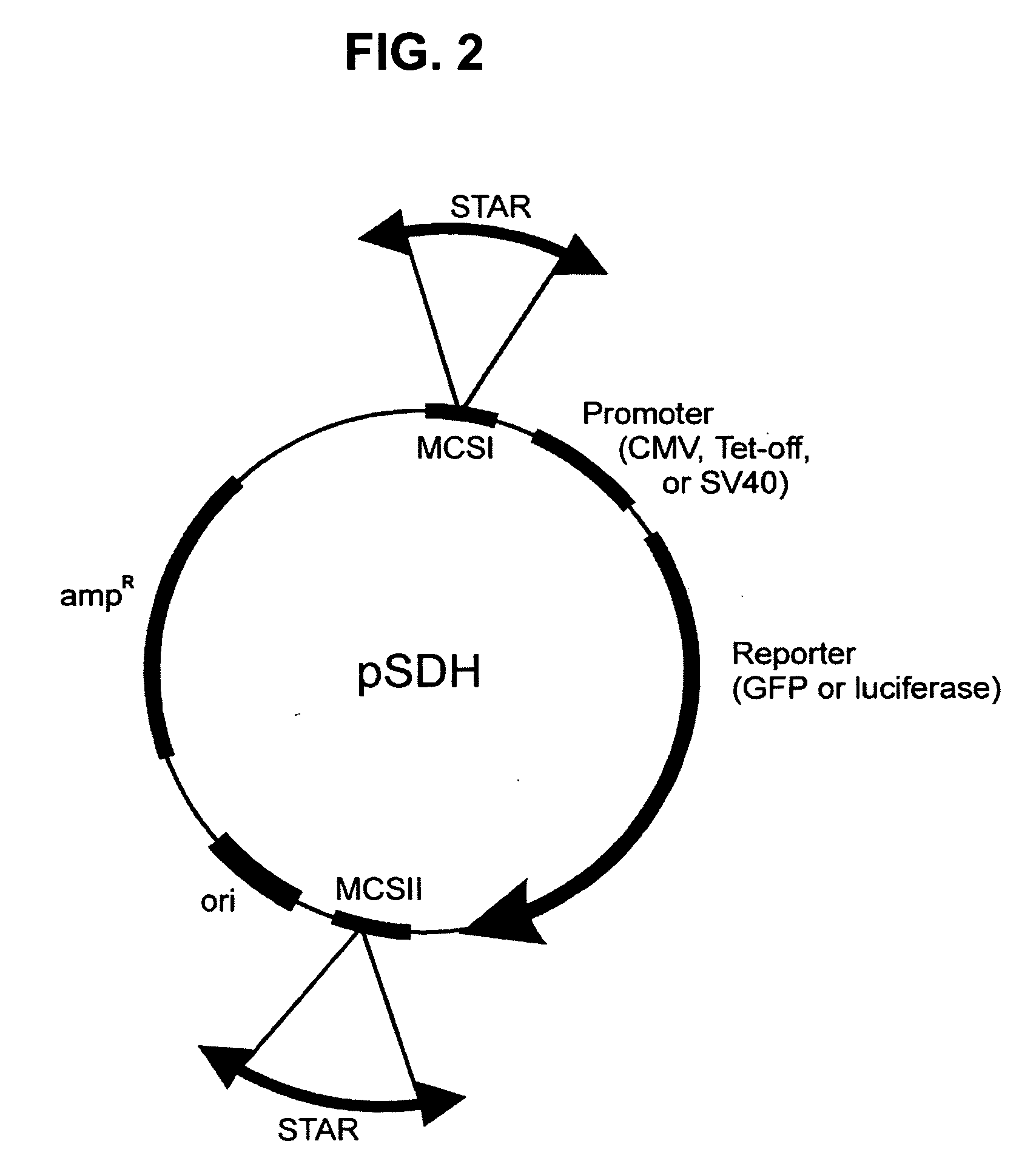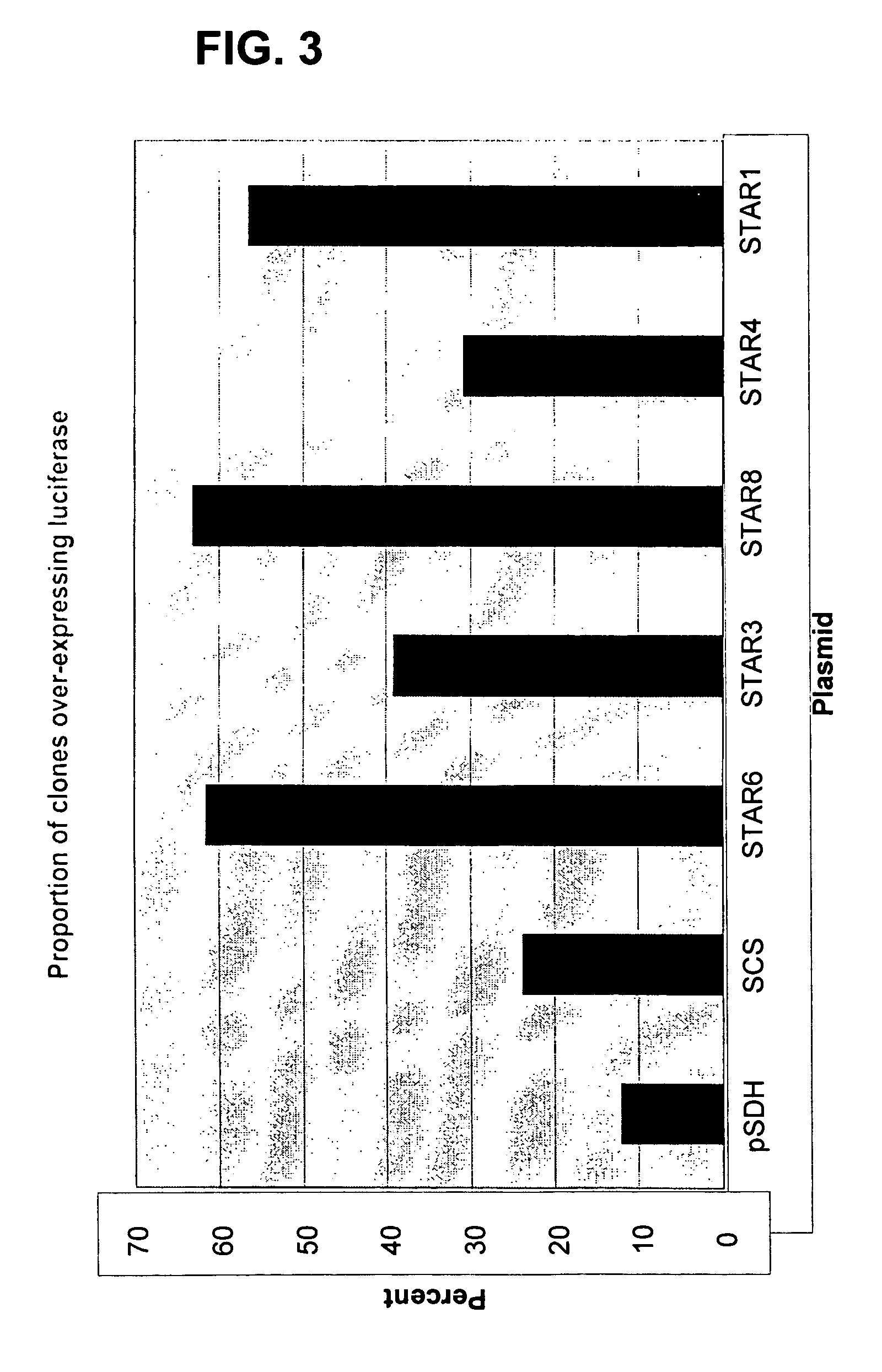Nucleic acid sequences having gene transcription regulatory qualities
a technology of nucleic acid sequences and gene transcription, applied in the field of medicine and cellular biology, can solve the problems of difficult to predict with any kind of accuracy the level of expression, and the design of expression cassettes is still often driven by trial and error, so as to improve enhance the quality. , the effect of stabilizing the quality of gene transcription
- Summary
- Abstract
- Description
- Claims
- Application Information
AI Technical Summary
Benefits of technology
Problems solved by technology
Method used
Image
Examples
example 1
Methods to Isolate STAR Elements
[0062] Materials and methods: Plasmids and strains. The selection vector for STAR elements, pSelect-SV40-zeo (“pSelect”, FIG. 1) is constructed as follows: the pREP4 vector (Invitrogen V004-50) is used as the plasmid backbone. It provides the Epstein Barr oriP origin of replication and EBNA-1 nuclear antigen for high-copy episomal replication in primate cell lines; the hygromycin resistance gene with the thymidine kinase promoter and polyadenylation site, for selection in mammalian cells; and the ampicillin resistance gene and colE1 origin of replication for maintenance in Escherichia coli. The vector contains four consecutive LexA operator sites between XbaI and NheI restriction sites (Bunker and Kingston, 1994). Embedded between the LexA operators and the NheI site is a polylinker consisting of the following restriction sites: HindIII-AscI-BamHI-AscI-HindIII. Between the NheI site and a SalI site is the Zeocin resistance gene with the SV40 promoter...
example 2
Expression Characteristics of the Transgene that are Due to the STAR
[0075] Background: site-specific recombination is used to precisely remove heterologous DNAs from their chromosomal locations. This is routinely carried out by one of two systems: the cre recombinase and loxP target of bacteriophage P1 (Feng et al., 1999), or the FLP recombinase and FRT (FLP recombinase target) of yeast (Wigley et al., 1994). In these systems, a DNA region (usually containing a reporter gene and / or a selectable marker) is flanked in the chromosome by the loxP or FRT target. The activity of the recombinase then catalyzes the precise excision of the DNA region from the chromosome. The recombinase resolves its two recognition sequences to a single site, deleting the sequence between them. Thus, a span of DNA must be flanked by target sites to be subsequently deleted in vivo upon introduction or activation of recombinase (Schwenk et al., 1995; Dymecki, 1996). The Cre and Flp recombinases catalyze recom...
example 3
Sequence Analysis of STARs; Determination of Minimal Essential Sequence for Element Function; Sequence Conservation Among Elements; and Properties of Tandem and Multiple Elements
[0079] Background: DNA fragments containing STAR elements are isolated by genetic selection using the pSelect (FIG. 1) plasmid. This section describes the approach to characterize the DNA sequences within those fragments that have STAR activity.
[0080] Protocols: DNA sequence: Oligonucleotides are designed based on the sequence of the pSelect plasmid for sequencing the DNA fragments. The fragments are sequenced using the dideoxy chain termination technique (Sanger et al., 1977). DNA sequences are then localized to chromosome position using the public human genome sequence database (www.ncbi.nlm.nih.gov:80 / cgi-bin / Entrez / hum_srch?chr=hum_chr.inf&query). Genes and gene density in the vicinity of the fragment sequence are recorded from the genome sequence annotation. Transcriptional activity of those genes is ...
PUM
| Property | Measurement | Unit |
|---|---|---|
| concentration | aaaaa | aaaaa |
| concentration | aaaaa | aaaaa |
| concentration | aaaaa | aaaaa |
Abstract
Description
Claims
Application Information
 Login to View More
Login to View More - R&D
- Intellectual Property
- Life Sciences
- Materials
- Tech Scout
- Unparalleled Data Quality
- Higher Quality Content
- 60% Fewer Hallucinations
Browse by: Latest US Patents, China's latest patents, Technical Efficacy Thesaurus, Application Domain, Technology Topic, Popular Technical Reports.
© 2025 PatSnap. All rights reserved.Legal|Privacy policy|Modern Slavery Act Transparency Statement|Sitemap|About US| Contact US: help@patsnap.com



